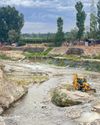
"Centralisation is a concern"
C PRAJENDRAN
ADJUNCT PROFESSOR, NATIONAL INSTITUTE OF ADVANCED STUDIES, BENGALURU
The Union Cabinet's approval for the National Research Foundation (NRF) Bill has been received with mixed feelings. Mostly modelled after the US' National Science Foundation, NRF has been discussed and developed since the time of the Manmohan Singh government. It has now been approved with an outlay of 50,000 crore for the next five years, more than half of which is expected to be contributed by the private sector. This is a meagre amount, given that India's funding for scientific research is already much less than other BRICS nations (Brazil, Russia, China and South Africa).
Besides, according to the Bill, the proposed entity will be administered by a governing body of "eminent" researchers and professionals, presided by the prime minister, and with an executive council chaired by the principal scientific advisor. This top-heavy management setup will likely lead to over-centralisation-as against the proclaimed intention of having a decentralised mechanism for science funding.
This cannot be overlooked in terms of the suspicion that a part of the fund is likely to be spent on belief-based traditional knowledge systems. There are also concerns about the criteria that would be used to select experts in the governing and executive bodies.
To unleash the full potential of Indian science and to improve the science-technology-innovation ecosystem, we require a vibrant and responsive financial system, which is autonomous, more participatory and less bureaucratic.
"First, close gaps in education"
ARINDAM GHOSH
PROFESSOR, DEPARTMENT OF PHYSICS, INDIAN INSTITUTE OF SCIENCE, BENGALURU
Denne historien er fra August 01, 2023-utgaven av Down To Earth.
Start din 7-dagers gratis prøveperiode på Magzter GOLD for å få tilgang til tusenvis av utvalgte premiumhistorier og 9000+ magasiner og aviser.
Allerede abonnent ? Logg på
Denne historien er fra August 01, 2023-utgaven av Down To Earth.
Start din 7-dagers gratis prøveperiode på Magzter GOLD for å få tilgang til tusenvis av utvalgte premiumhistorier og 9000+ magasiner og aviser.
Allerede abonnent? Logg på

In leading role again
MOVIES AND WEB SERIES ARE ONCE AGAIN BEING SET IN RUSTIC BACKGROUNDS, INDICATING A RECONNECT BETWEEN CINEMA AND THE COUNTRYSIDE

One Nation One Subscription comes at a huge cost
As top US universities scrap big deals with top scientific publishers, India’s ONOS scheme seems flawed and outdated

Return of Rambhog
Bid to revive and sell the aromatic indigenous paddy variety has led to substantial profits for farmers in Uttar Pradesh's Terai region

Scarred by mining
Natural springs of Kashmir drying up due to illegal riverbed mining

Human-to-human spread a mutation away
CANADA IN mid-November confirmed its first human case of avian influenza, with a teenager in the British Columbia being hospitalised after contracting the H5N1 virus that causes the disease. The patient developed a severe form of the disease, also called bird flu, and had respiratory issues. There was no known cause of transmission.

True rehabilitation
Residents of Madhya Pradesh's Kakdi village take relocation as an opportunity to undertake afforestation, develop sustainable practices

INESCAPABLE THREAT
Chemical pollution is the most underrated and underreported risk of the 21st century that threatens all species and regions

THAT NIGHT, 40 YEARS AGO
Bhopal gas disaster is a tragedy that people continue to face

A JOKE, INDEED
A CONFERENCE OF IRRESPONSIBLE PARTIES THAT CREATED AN OPTICAL ILLUSION TO THE REALITY OF A NEW CLIMATE

THINGS FALL APART
THE WORLD HAS MADE PROGRESS IN MITIGATING EMISSIONS AND ADAPTING TO CLIMATE IMPACTS. BUT THE PROGRESS REMAINS GROSSLY INADEQUATE